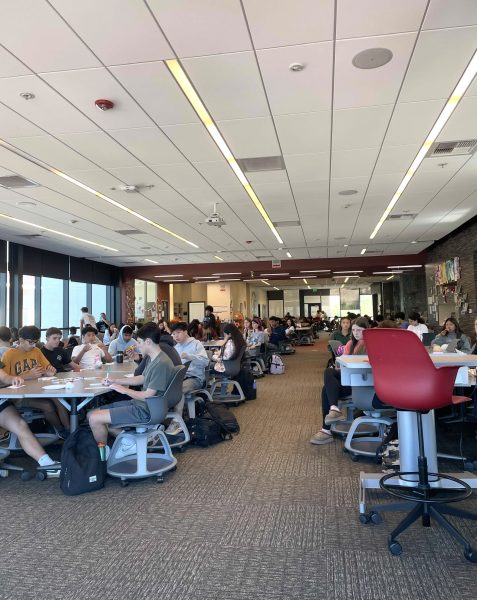Student Non-Profits: Selfless or Selfish

Students are depicted with boxes of donation materials for their non-profit organizations. Starting a non-profit organization is marketed as a “silver bullet” towards college admission, but the consequences of doing so solely for college acceptance can be dire.
Empty tubs of Ben and Jerrys, tear stained tissues, and “Driver’s License” on repeat. No this isn’t a high school breakup, it’s college admissions season. For most high school students, college admission season isn’t the shower of acceptances seen on TV shows and in movies. Increasingly, it’s become college rejection season.
As acceptance rates keep decreasing, it seems that being conventionally “smart” isn’t enough to get into a top school. With Massachusetts Institute of Technology’s(MIT) acceptance rate dropping to just 6.7% this year, ambitious students have been foraging for a “silver bullet” to guarantee acceptance at such prestigious universities. Many have found their panacea in starting non-profit organizations.
“Non-profits in general are very valuable contributions to society,” Monte Vista counselor Krisin Tegeler said. “The purpose is to help different causes where there is a specific need, so it can be a very powerful force.”
Monte Vista senior Ronit Batra is one of many high school students to start a non-profit. During early months of the pandemic, he chose to start his non-profit Help SOAR to bolster the devastated restaurant industry. Help SOAR’s underrepresented mission inspired Batra to start his own organization rather than joining an existing non-profit. “It is deeply gratifying to speak one-on-one with the people you are serving,” Batra said.
Unfortunately, the passion Batra exudes isn’t ubiquitous among all students who start non-profits. Problems arise when students start these organizations out of selfishness rather than selflessness.
Nowadays, “Founder and CEO” is a highly coveted title among overachieving high school students. Some will start their own non-profits just to flaunt it in lengthy resumes and college essays. For many, this title doesn’t come without a cost. A price that’s paid by existing non-profit organizations. To legitimize their organizations, high school founders will often seek funding and media exposure. A TED Talk or two, features on local and even national news and a GoFundMe page thrown into the mix might seem impressive to colleges, but the impacts seen by established non-profits in the same field are inevitable.
Efforts for exposure directly compete with existing non-profits which rely heavily on media attention to obtain funding. As their name suggests, non-profits have no profits, so with diverted funding and a dwindling clientele, non-profits are put in a vulnerable state, where some even have to disband entirely.
While some non-profits are forced to dissolve, student non-profits often do so voluntarily. Many students started non-profits have expiration dates that read, “Welcome to [insert ivy league here].”
“Students need to be very cautious because there’s a shelf life,” Tegeler said.
Without intention to continue fostering non-profits in college, the communities that are helped by these organizations are abandoned. If similar organizations are driven out, participants are truly left with nowhere to go, making the entire operation counteractive. Funding, media attention, and resources poured into organizations result in nothing but acceptance letters for the chairpeople and devastation for the people they are supposed to serve.
The detriments of non-profits started purely out of self interest don’t even stop there.
Buzzwords like “helping the underserved” or ” supporting marginalized communities” are used to garner pity points while exploiting the groups they claim to help. Minorities are treated like
pawns in the college admissions process, whilst organization founders play a metaphorical game of chess hoping to checkmate their competition.
The consequences extend beyond people involved with self-serving non-profits, they also affect well intentioned students. “What is happening is admissions offices are seeing this as a cliche,” Tegeler said. Students who are truly passionate about their organization’s cause are
harmed. With the surplus of students starting non-profits, it’s hard for admission officers to tell who is truly altruistic, instead labeling most or all student non-profits as selfishly established.
On the surface, student non-profits are altruistic, but many are like fireworks. A spark can create flashy displays of light and noise, but the impacts are quickly fleeting. The oversaturation
of student started non-profits is a sad consequence of the gamification of the college admissions system, where getting into a top college is the priority, no matter the carnage. When non-profits serve no other purpose than a couple of sentences in a Common App essay, it’s time to reevaluate who the organization truly serves. To put it briefly, a non-profit should be about fulfilling a mission rather than securing an admission.

Olivia Brandeis is a senior at Monte Vista and is in her fourth year at The Stampede. This year, she’s...






